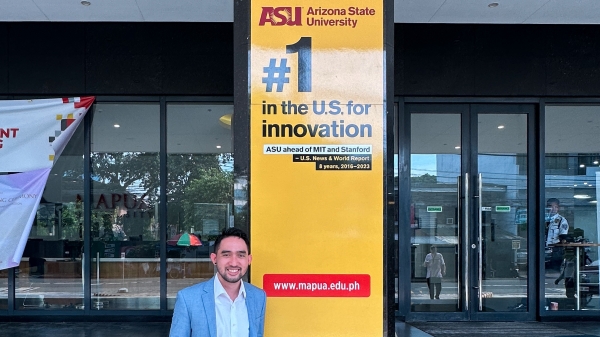Can connected devices reduce hospital readmissions?

Photo courtesy of iStock/Getty Images
Health care providers are increasingly relying on technology when it comes to patient care.
Many in the industry believe this allows caregivers to monitor health-related behavior to proactively intervene rather than wait for an adverse event.
It sounds reasonable and even better than the older system, but is it true?
An Arizona State University professor believes it was worth investigating.
Tan Lekwijit, an assistant professor in the Department of Information Systems at ASU’s W. P. Carey School of Business, researches how health care providers can leverage information technology and make operational improvements to achieve better health and operational outcomes.
His new study, “Evaluating the Efficacy of Connected Healthcare: An Empirical Examination of Patient Engagement Approaches and Their Impact on Readmission,” was recently published in an academic journal. It reviewed how humans and technology are interfacing in today’s health care system.
Here’s what Lekwijit told ASU News about his findings:
Question: What inspired you to write this paper?
Answer: We were motivated by the rapid growth of connected health devices and systems. In the past, before the possibility of being connected technologically to the health care system, patients made decisions related to diet, exercise regimen or medication adherence — without the involvement of care providers. Now, connected health devices such as smart pill bottles, connected scales and wearable health trackers can transmit clinically relevant data to information systems that can relay this information to patients and providers.
Active patient engagement and feedback systems have the potential to reduce the number of preventable readmissions and ultimately reduce health care costs. Despite this enormous upside, there is limited evidence for the effectiveness of connected health care and little guidance on effectively implementing it. Our goal was to address this gap by formally evaluating the impact of a connected health system and offering recommendations for its implementation.
Q: What is the context of the connected health system you study?
A: We examined a connected health system that aimed to improve medication adherence and reduce the number of readmissions after myocardial infarction. Our study is part of a larger research project that involved a yearlong intervention with 1,000 patients. The intervention combined wireless pill bottles that electronically track openings and transmit them to the care team, lottery-based incentives, and a multi-tiered feedback system involving automated messaging, manual messaging and phone calls. The connected health system delivered these messages and calls to the patients or their enlisted partners at increasing escalation levels.
Although the implementation costs are usually straightforward to estimate, the benefits of engagement systems to improve medication adherence and the impact of higher adherence on readmission often need to be clarified. Moreover, it is unclear how to effectively engage with non-adherent patients to minimize the number of readmissions given limited human resources.
This paper investigates the efficacy of this connected health care in promoting medication adherence, examines the relationship between medication adherence and readmission, and develops a dynamic readmission risk-scoring model to help target non-adherent patients more effectively.
Q: How do hospital staff prioritize patients in this system?
A: The challenge was that there was no clear prioritization system. The staff follow a standard protocol with five escalation levels, starting with automated messages in the first few days of non-adherence and potentially leading to phone calls to a patient’s partner after seven days of non-adherence. However, we did not deliver the intervention in a perfectly consistent manner because of operational constraints. This is a very common problem in many hospitals, as a small care team is often responsible for monitoring and taking care of hundreds of patients. We wanted to come up with a better way to deliver the intervention given the fact that we cannot contact every non-adherent patient every day.
Q: What are some of your suggested implementations to improve this system?
A: We offer two key recommendations. First, given hospitals’ limited resources, we should deliver the intervention to those who need it the most. To this end, we developed a dynamic readmission risk-scoring model that includes daily medication adherence as predictors. Our counterfactual analysis shows that prioritizing patients with the highest readmission risk can reduce readmissions by 10% while maintaining the same level of effort.
Second, we recommend an optimal escalation strategy. We show that patients are significantly more likely to become adherent when they or their partners receive intervention that involves personalized feedback and when the intervention is escalated quickly and consistently. Our results imply that, to effectively make a non-adherent patient adherent again, we should start calling the patient as soon as she becomes non-adherent. Receiving a personal phone call immediately after the first day of non-adherence more than doubles the probability of becoming adherent again. Then, if non-adherence continues, we should escalate to manual messages and calls to the patient’s partner on the following days.
More Health and medicine
College of Health Solutions medical nutrition student aims to give back to her Navajo community
As Miss Navajo Nation, Amy N. Begaye worked to improve lives in her community by raising awareness about STEM education and health and wellness.After her one-year term ended last month, Begaye’s…

Linguistics work could improve doctor-patient communications in Philippines, beyond
When Peter Torres traveled to Mapúa University in the Philippines over the summer, he was shocked to see a billboard promoting Arizona State University.“It wasn’t even near the university,” said…

Turning data into knowledge: How Health Observatory at ASU aims to educate public
This is how David Engelthaler described his first couple of months on the job as executive director of the Health Observatory at Arizona State University:“It’s been a little bit of drinking from the…